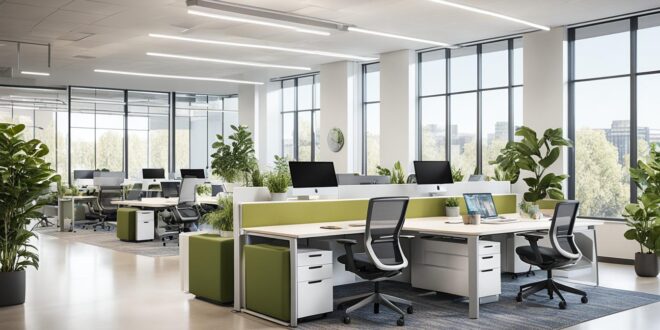In today’s rapidly evolving business landscape, the way we work is constantly changing. With technological advancements and shifting workplace dynamics, the concept of a traditional office is being reimagined. Future workspaces are designed not only to enhance productivity but also to prioritize employee well-being.
Designing productive offices that align with modern office trends is crucial for businesses that aim to attract and retain top talent. Innovative office spaces, eco-friendly office designs, and smart office solutions for productivity are becoming increasingly popular.
The future of remote workspaces has also gained traction, with companies embracing technology to create seamless virtual collaboration environments. Sustainable office practices are another key consideration, as businesses recognize the importance of reducing their carbon footprint and promoting a greener workplace.
In this article, we will explore the integration of innovative design and technology in future workspaces. We will delve into the key elements of a healthy workspace, including the role of natural light, biophilic design, ergonomic furniture, flexible spaces, air quality, acoustics, and color and materials. Furthermore, we will discuss the steps businesses can take to create a healthy workspace and the long-term benefits of investing in employee well-being.
As we navigate the challenges and opportunities presented by the changing landscape of work, it is crucial to prioritize the design of our workspaces to promote productivity, wellness, and success.
The Connection between Workspace Design, Wellness, and Productivity
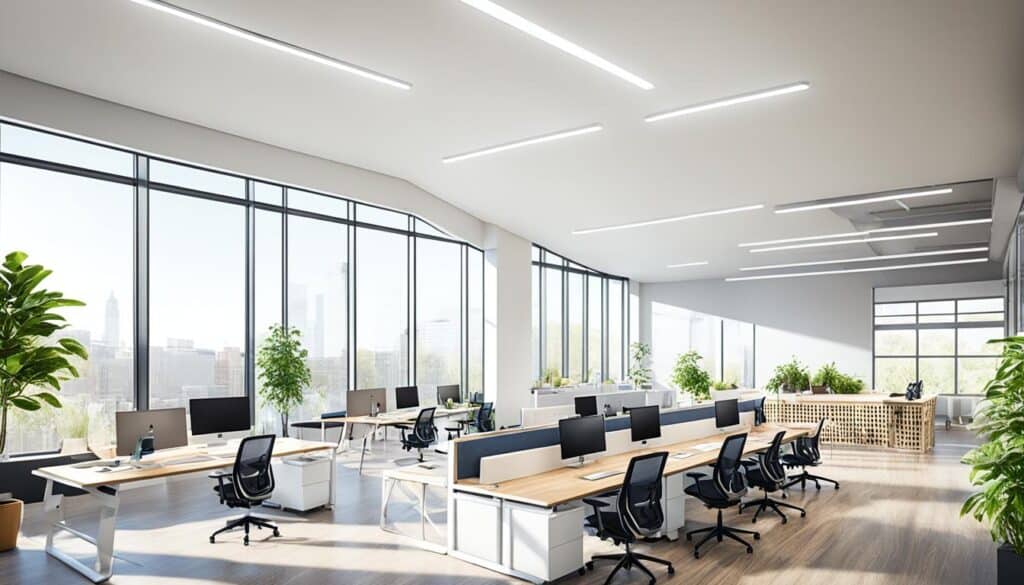
Research has shown that the design of a workspace plays a crucial role in enhancing employee wellness, engagement, and productivity. A well-designed workspace can positively impact employees’ physical and mental well-being, creating a healthier and more vibrant work environment.
Workspace design goes beyond aesthetics; it encompasses various elements that contribute to a productive and positive atmosphere. By creating a workplace that prioritizes employee wellness, organizations can foster a culture that values the well-being of their workforce.
Work-Life Balance and Flexible Work Options
An important aspect of workspace design is supporting work-life balance and providing employees with flexible work options. This includes offering flexible work hours and remote work arrangements, allowing employees to achieve a better balance between their professional and personal lives.
Flexible work options empower employees to manage their time effectively, reduce stress levels, and improve overall job satisfaction. By recognizing the importance of work-life balance, organizations can create a supportive and fulfilling work environment that promotes employee well-being and productivity.
The Influence of Workplace Culture
Workspace design is closely intertwined with workplace culture. A positive and inclusive culture encourages collaboration, creativity, and open communication, leading to increased employee engagement and productivity.
When designing a workspace, it is essential to consider the values, goals, and norms of the organization and align them with the physical environment. By fostering a supportive and inspiring workplace culture through effective design, companies can create an environment where employees feel motivated, valued, and empowered.
Creating a workspace that promotes employee wellness, productivity, and work-life balance is crucial for organizations seeking to attract and retain top talent. By understanding the connection between workspace design, wellness, and productivity, companies can unlock the potential for growth, innovation, and success.
Key Elements of a Healthy Workspace
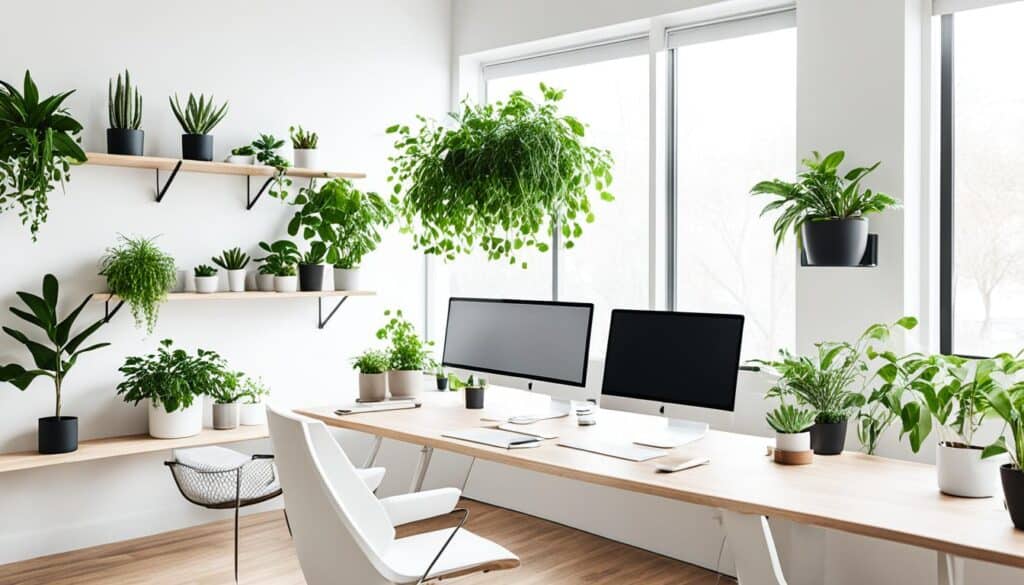
In order to create a healthy workspace that promotes employee well-being and productivity, several key design elements should be considered. These include:
Natural Light
Introducing ample natural light into the workspace has numerous benefits. It not only improves mood and energy levels but also enhances productivity and overall well-being. Natural light can be maximized by strategically placing workstations near windows or installing skylights throughout the office.
Biophilic Design
Biophilic design incorporates elements of nature into the workspace to create a more calming and rejuvenating environment. This can be achieved through the addition of plants, water features, and views of nature. Biophilic design has been proven to reduce stress levels, increase focus, and improve air quality.
Ergonomic Furniture
Providing ergonomic furniture is crucial for employee comfort and preventing musculoskeletal disorders. Adjustable chairs, standing desks, and monitor arms allow employees to maintain proper posture, reduce strain, and increase overall productivity. The use of ergonomic furniture supports a healthier and more comfortable work experience.
Flexible Spaces
Designing flexible workspaces that cater to different tasks and work styles is essential. Offering open areas for collaboration, private zones for quiet focused work, and breakout areas for informal meetings or relaxation can significantly increase productivity. Providing employees with the flexibility to choose their workspace based on their needs and preferences promotes a positive and productive work environment.
Air Quality
Poor air quality can lead to various health issues and decreased productivity. Ensuring good air quality through proper ventilation, air purifiers, and the use of low-VOC materials creates a healthier work environment. Additionally, incorporating indoor plants can improve air quality by naturally purifying the air.
Acoustics
Noise pollution in the workplace can be highly distracting and detrimental to productivity. Incorporating sound-absorbing materials, acoustic panels, and creating designated quiet areas can help minimize noise levels and create a more conducive work environment. Alternatively, providing noise-canceling headphones can help employees focus and concentrate on their tasks.
Color and Materials
The selection of colors and materials in the workspace can have a significant impact on employee mood and productivity. Choosing calming and neutral colors promotes relaxation and a sense of tranquility, while vibrant colors can stimulate creativity and energy. It is important to opt for visually appealing and environmentally friendly materials to create a visually pleasing and sustainable workspace.
By incorporating these key elements of a healthy workspace, employers can create an environment that prioritizes employee well-being and productivity.
Natural Light and Biophilic Design
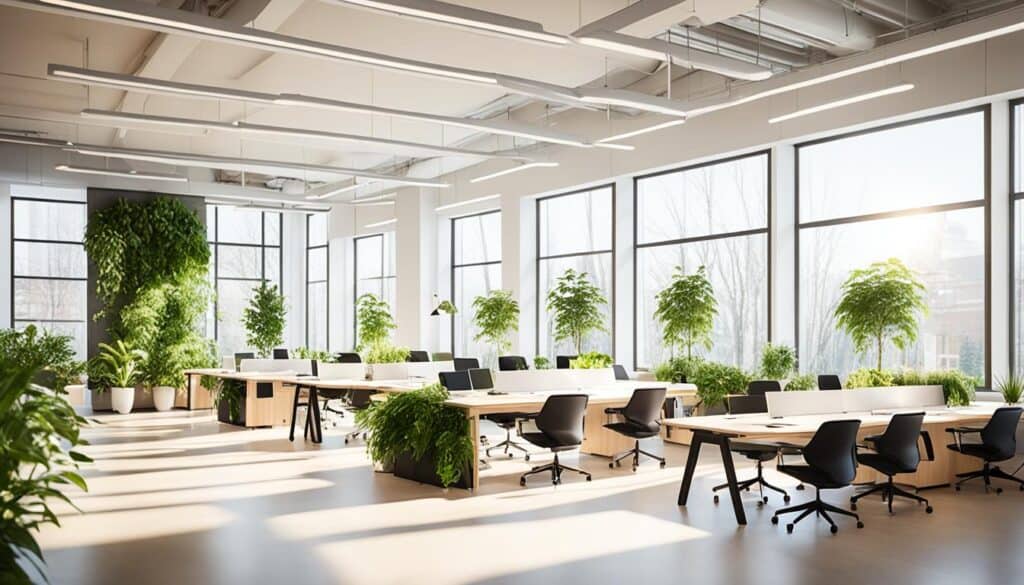
One of the key elements in creating a healthy and productive workspace is the incorporation of natural light. Natural light has numerous benefits, including improving mood, increasing energy levels, and boosting overall well-being. By allowing ample natural light to enter the workspace, employees are more likely to feel alert, focused, and engaged.
Biophilic design, which refers to the integration of natural elements into the built environment, is another essential aspect in creating a harmonious workspace. Incorporating plants, water features, and views of nature can have a profound impact on employee well-being and performance.
Plants not only enhance the aesthetics of the workspace but also improve air quality by filtering pollutants and increasing oxygen levels. They create a sense of calm and tranquility, reducing stress and promoting mental clarity. Additionally, the presence of plants has been linked to increased creativity, cognitive function, and productivity.
Water features, such as fountains or indoor waterfalls, contribute to a serene and calming atmosphere. The gentle sound of flowing water can help mask distracting noises, improving focus and concentration. Moreover, water features add a touch of nature to the workspace, enhancing the overall biophilic design.
Views of nature, whether through large windows or strategically placed artwork, provide employees with glimpses of the outside world. Studies have shown that exposure to views of nature can reduce stress, enhance mood, and increase job satisfaction. Access to natural views also inspires a connection to the environment, promoting environmental awareness and sustainability.
Incorporating natural light and elements of biophilic design into the workspace creates a more pleasant, calming, and productive environment. Employees benefit from improved well-being, higher levels of focus, and increased creativity. By investing in these design elements, organizations can nurture a healthy workforce and cultivate a positive and thriving work environment.
Ergonomic Furniture
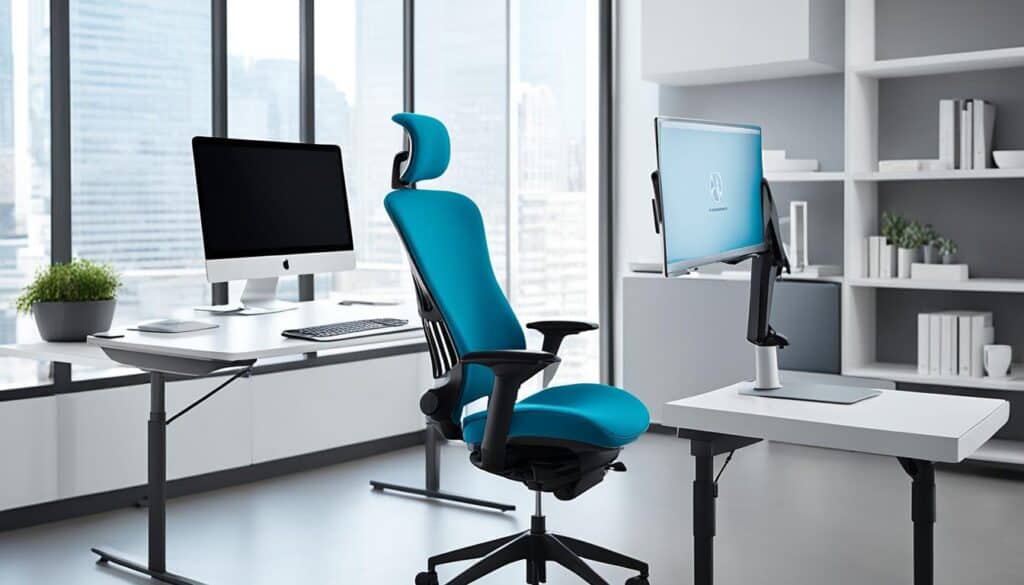
Creating a comfortable and supportive workspace is essential for employee well-being and productivity. Ergonomic furniture plays a significant role in achieving this goal.
Musculoskeletal disorders, such as back pain and repetitive strain injuries, can greatly impact employee health and productivity. However, by providing ergonomic seating and workstations, you can significantly reduce the risk of these disorders.
Adjustable chairs are one of the key components of ergonomic furniture. They allow employees to customize their seating position to achieve optimal comfort and support. Properly adjusted chairs promote good posture, which can prevent strain on the spine and muscles.
Standing desks have gained popularity in recent years due to their ergonomic benefits. These desks allow employees to switch between sitting and standing throughout the day, promoting movement and reducing the negative effects of prolonged sitting. Standing desks can help alleviate back pain and improve circulation.
Another important element of ergonomic furniture is monitor arms. These adjustable mounts allow users to position their monitors at eye level, reducing strain on the neck and minimizing the risk of eyestrain. By promoting proper alignment, monitor arms contribute to a more comfortable and productive work environment.
Incorporating ergonomic furniture into your workspace can have a positive impact on employee well-being and productivity. By investing in adjustable chairs, standing desks, and monitor arms, you prioritize the health and comfort of your employees, helping them work more comfortably and efficiently.
- Reduce the risk of musculoskeletal disorders
- Enhance employee comfort and well-being
- Promote good posture and prevent strain
- Encourage movement with standing desks
- Improve ergonomics with adjustable monitor arms
Flexible Spaces

Creating flexible spaces in the workplace is pivotal in supporting the diverse needs of employees and promoting productivity. By offering a variety of workspaces, including open areas for collaboration and quiet spaces for focused work, companies can ensure that their employees have the right environment for every task at hand.
Open areas encourage collaboration and foster a sense of teamwork. These spaces provide employees with opportunities to interact, exchange ideas, and work together towards common goals. Whether it’s brainstorming sessions, team meetings, or group projects, open areas promote a dynamic and collaborative work culture.
On the other hand, quiet spaces are essential for tasks that require deep concentration and focus. Employees can retreat to these designated areas when they need to work on complex projects, engage in critical thinking, or simply find solitude to complete their work uninterrupted. By providing quiet spaces, companies acknowledge the importance of individual productivity and create an environment conducive to deep work.
Breakout areas serve as rejuvenating spaces that offer a change of scenery within the office. These areas are designed to provide employees with a space for informal meetings, impromptu discussions, or even relaxation. Whether it’s catching up with colleagues over a cup of coffee or taking a short break to recharge, breakout areas offer a refreshing escape from the regular workstations.
By incorporating flexible spaces into the office design, companies not only cater to the different working styles and preferences of their employees but also encourage collaboration, focus, and creativity. The flexibility in workspaces enables employees to choose the environment that best suits their specific tasks, resulting in increased satisfaction, engagement, and productivity.
- Open areas for collaboration and teamwork
- Quiet spaces for focused work
- Breakout areas for informal meetings and relaxation
Air Quality
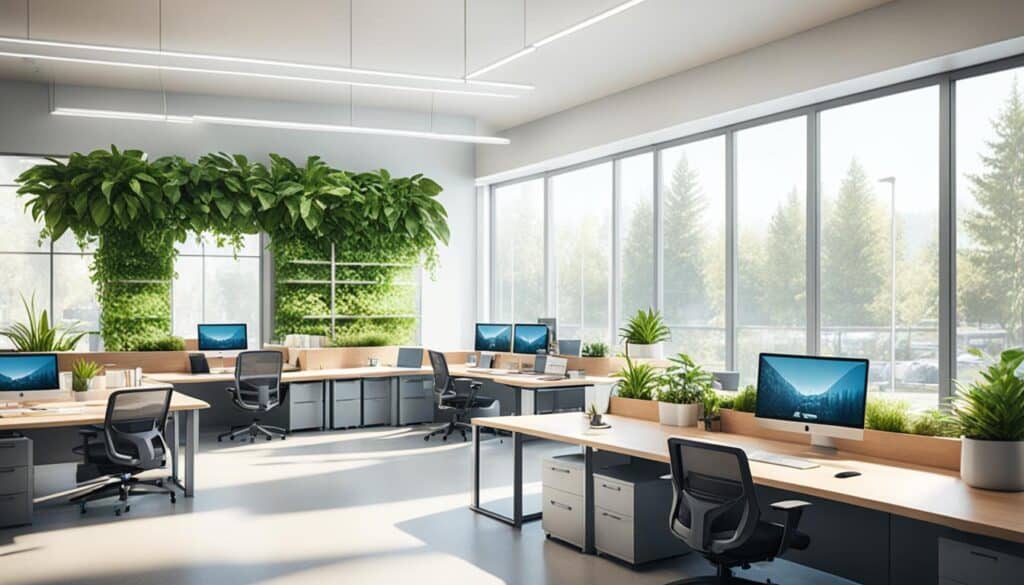
Poor indoor air quality can have a significant impact on employee health and well-being. It can lead to increased illnesses and absenteeism, ultimately affecting productivity in the workplace. To create a healthy work environment, it is essential to prioritize air quality and take necessary measures to improve it.
Proper Ventilation
One crucial aspect of maintaining good air quality is ensuring proper ventilation throughout the workspace. Implementing a well-designed ventilation system helps remove indoor pollutants and circulate fresh air. Adequate ventilation also helps regulate temperature and humidity levels, creating a comfortable environment for employees.
Air Purifiers
Using air purifiers can be an effective strategy to improve air quality in the workspace. Air purifiers help remove dust, pollen, mold spores, and other allergens from the air, reducing the risk of respiratory problems and allergies among employees. It is important to choose air purifiers with high-efficiency particulate air (HEPA) filters for optimal results.
Low-VOC Materials
Volatile Organic Compounds (VOCs) are harmful chemicals emitted by many building materials and furnishings. These compounds can contribute to poor indoor air quality and cause various health issues. To create a healthier workspace, opt for low-VOC materials such as paints, adhesives, and furniture. Look for products with low or zero VOC content to reduce the release of harmful chemicals.
Incorporation of Plants
Indoor plants not only add a touch of greenery to the workspace but also improve air quality. Plants help filter out pollutants and release oxygen, creating a more refreshing and oxygen-rich environment. Consider incorporating plants strategically throughout the office space to enhance air quality and promote a healthier work environment.
By prioritizing air quality through proper ventilation, the use of air purifiers, selection of low-VOC materials, and integration of plants, employers can create a workspace that supports the well-being and productivity of their employees.
Acoustics
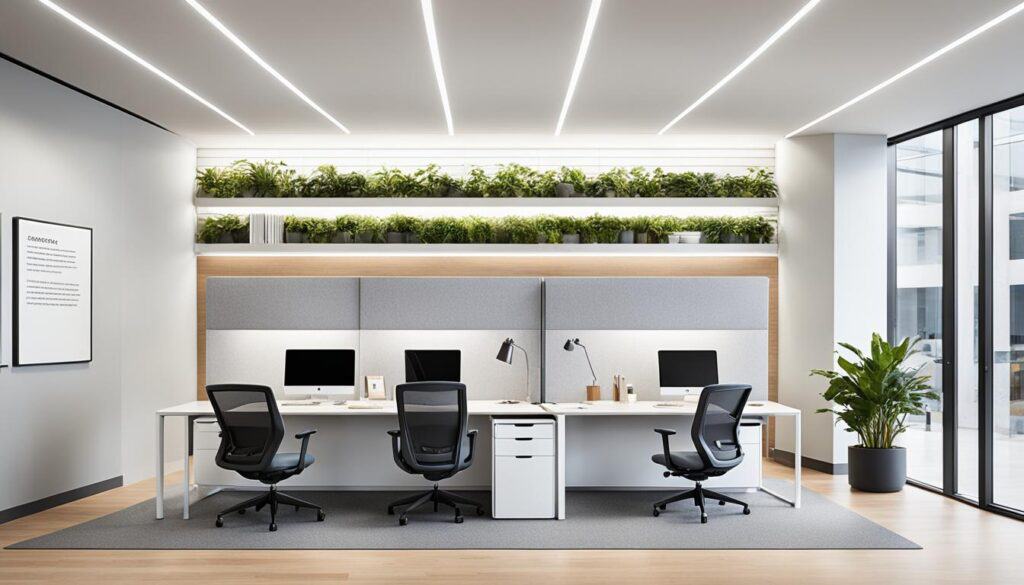
Noise pollution in the workplace can have a detrimental effect on employee well-being and productivity. Constant distractions and high noise levels contribute to increased stress and decreased focus. To create a more comfortable and productive environment, it is essential to address acoustics in the workspace.
One effective solution is to incorporate sound-absorbing materials throughout the office. These materials help reduce echo and reverberation, minimizing noise disturbances. Install acoustic panels on walls and ceilings to further enhance sound absorption and create a quieter atmosphere.
When designing spaces, it is crucial to consider appropriate noise levels and create dedicated quiet areas where employees can work without disruptions. These areas can serve as retreats for focused tasks or important meetings requiring concentration.
To provide a personalized solution for combating workplace noise, employees can also utilize noise-canceling headphones. These headphones help block out external sounds, allowing individuals to concentrate on their work in a distraction-free environment.
By addressing acoustics and implementing measures to reduce noise pollution, businesses can create a more productive and peaceful workspace that supports employee well-being and enhances overall performance.
Color and Materials
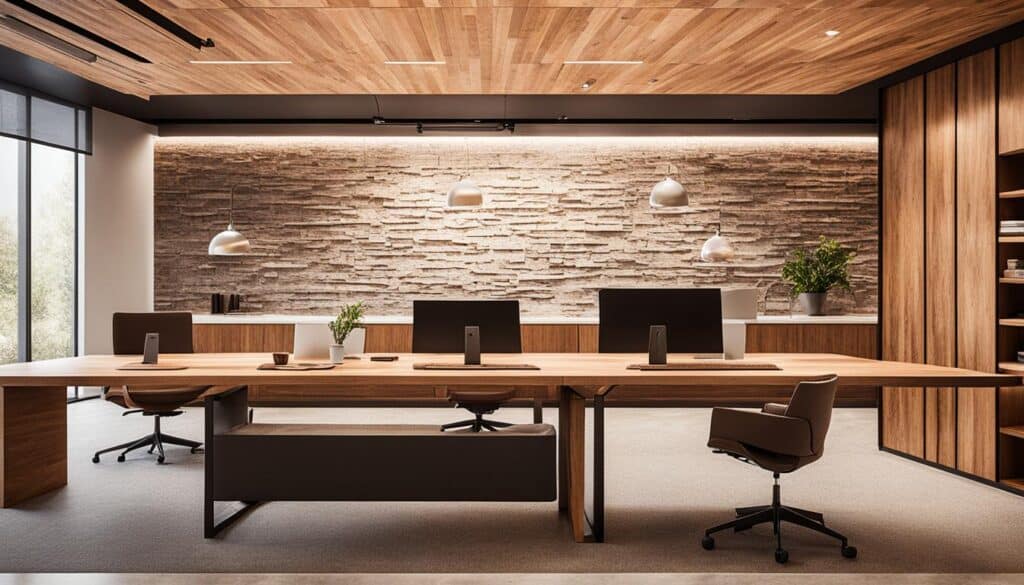
In the design of a workspace, the choice of color and materials is crucial, as it directly impacts employee mood and productivity. The right colors and materials can create a harmonious and stimulating environment that supports well-being and effectiveness.
To promote calmness and tranquility, it is advised to incorporate calming colors in the workspace. Neutral tones such as soft blues, greens, and earthy hues can create a sense of serenity and relaxation. These colors have a soothing effect on the mind and can help reduce stress levels, encouraging a more focused and productive mindset.
On the other hand, using vibrant colors can stimulate creativity and energy among employees. Shades of red, orange, and yellow can boost motivation and enthusiasm, inspiring new ideas and enhancing problem-solving abilities. These lively colors create an energetic atmosphere that can help drive innovation and collaboration.
Equally important to consider are the materials used in the workspace. Opting for visually appealing and environmentally friendly materials contributes to a healthy and productive environment. Incorporating sustainable and organic materials not only supports the well-being of employees but also aligns with a company’s commitment to environmental consciousness.
Steps to Create a Healthy Workspace
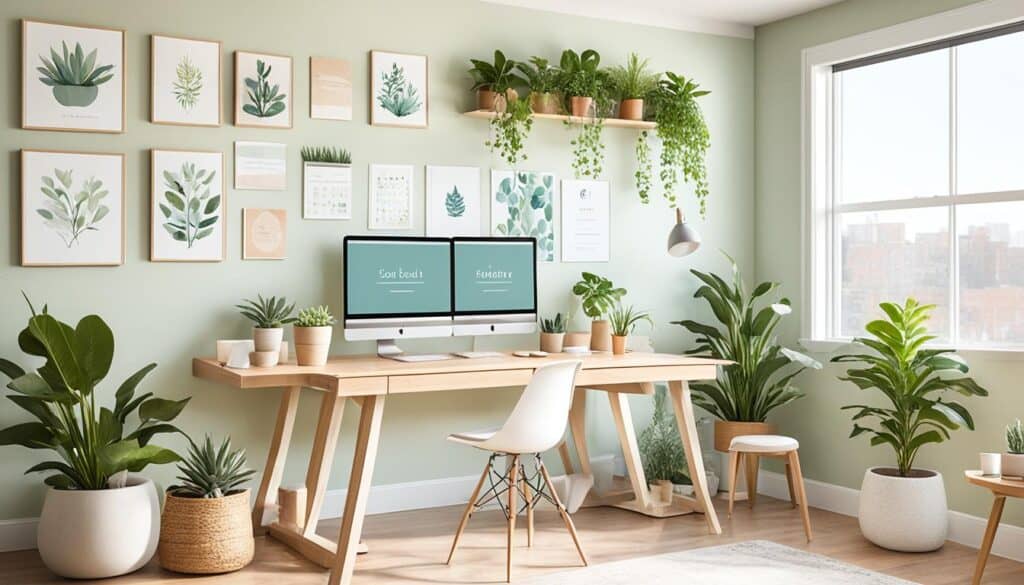
Creating a healthy workspace is a multi-faceted process that involves assessing the current office environment, collecting employee feedback, collaborating with professionals, implementing changes gradually, and monitoring progress. By following these steps, you can ensure that your workspace meets the highest standards for wellness and productivity.
To begin, carefully evaluate the office environment to identify areas that may need improvement. This includes examining aspects such as lighting, furniture, layout, and air quality. Consider the impact of natural light, ergonomic furniture, and a well-designed layout on employee well-being and productivity.
Next, actively seek feedback from your employees. Encourage them to share their thoughts and suggestions on how to create a healthier and more productive workspace. Employee input is invaluable in understanding their needs and preferences.
Collaborating with professionals who specialize in office design and wellness can provide valuable insights and expertise. These professionals can help you interpret employee feedback, propose design solutions, and guide you through the process of creating a healthy workspace.
Implementing changes gradually allows for a phased approach, minimizing disruption and allowing employees to adjust. Start with small improvements and gradually implement larger changes based on employee feedback and professional recommendations.
Once the changes are implemented, it’s crucial to continuously monitor the progress and impact on employee well-being and productivity. Regularly assess the workspace to ensure that the improvements are achieving the desired results.
By taking a comprehensive and systematic approach to creating a healthy workspace, you can enhance employee well-being, satisfaction, and productivity. Investing in a workspace that prioritizes employee health and comfort is a strategic decision that pays dividends in the long run.
The Long-term Benefits of a Healthy Workspace
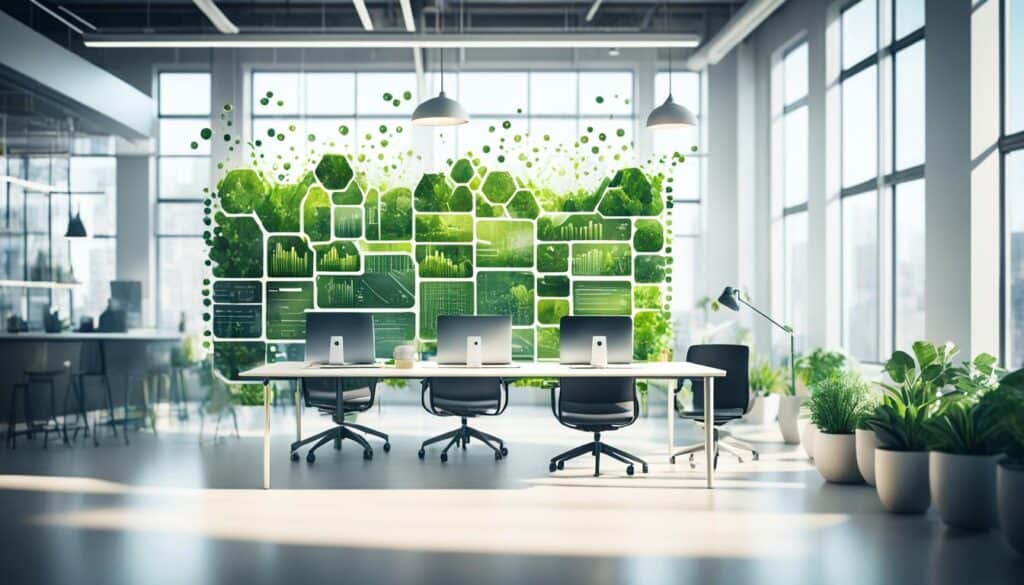
Investing in a healthy workspace not only yields immediate benefits for employee well-being and productivity but also establishes a solid foundation for the long-term success of the company.
Employee well-being is a crucial aspect of any organization. By creating a workspace that prioritizes the health and happiness of employees, companies can enhance employee satisfaction and overall job satisfaction. When employees feel valued, supported, and comfortable in their work environment, they are more likely to be engaged and motivated to perform at their best.
Furthermore, a healthy workspace plays a significant role in employee retention. Employees are more likely to stay with a company that provides a work environment that promotes their well-being. Creating a workspace that fosters a positive work-life balance, supports employee growth and development, and caters to their physical and mental health needs can contribute to higher employee retention rates.
Beyond employee satisfaction and retention, a healthy workspace is also instrumental in attracting top talent. In today’s competitive job market, talented individuals are not just looking for a job; they seek an environment that aligns with their values and supports their well-being. By investing in a healthy workspace, companies can position themselves as employers of choice and attract the best candidates.
Moreover, a healthy workspace enhances the reputation of a company. Organizations that prioritize employee well-being and design their workspaces accordingly are seen as progressive, caring, and forward-thinking. A positive reputation can attract potential clients, partners, and investors who value a company’s commitment to creating a healthy and productive work environment.
In addition to direct benefits, a healthy workspace indirectly contributes to increased business opportunities. A productive and engaged workforce is more innovative, creative, and efficient, leading to improved business performance. A well-designed workspace that supports collaboration, creativity, and overall employee well-being enhances the company’s competitive advantage, enabling it to seize new opportunities, drive growth, and outperform competitors.
Designing for Hybrid Work Models
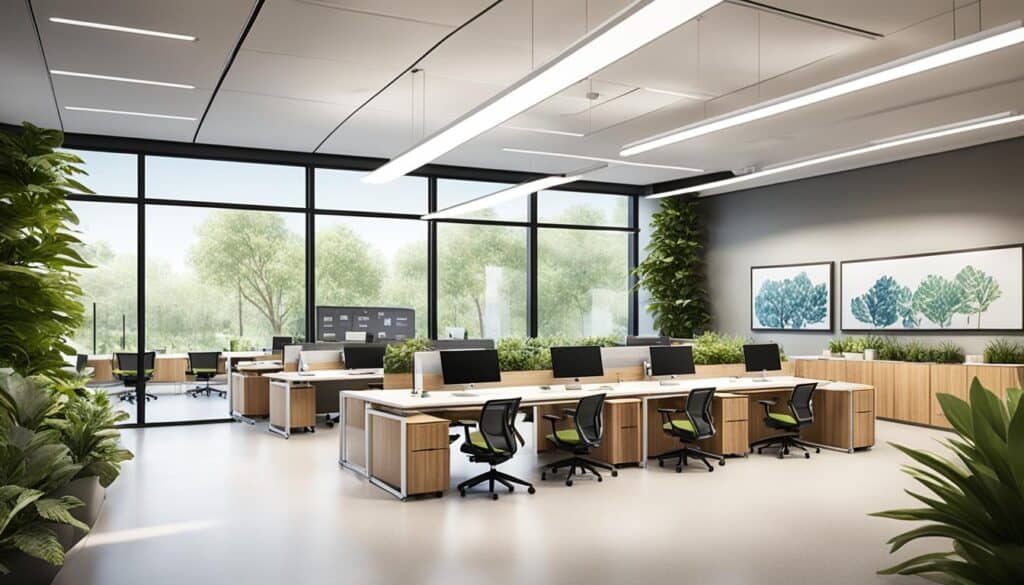
The rise of hybrid work models requires office designs that accommodate both in-office and remote work. To meet the needs of this evolving work model, flexible workspaces, collaboration spaces, and private zones equipped with technology are essential.
Flexible workspaces provide employees with the freedom to choose where and how they work. These versatile areas can be easily adapted to accommodate individuals or groups, allowing for seamless collaboration and productivity. With hybrid work models, the ability to quickly shift between individual workstations and collaborative spaces becomes crucial.
Collaboration spaces facilitate effective teamwork, enabling employees to come together in person and actively engage with one another. Equipped with the latest technology and tools, these spaces foster creativity, ideation, and knowledge sharing.
Private zones offer a quiet and focused environment for tasks that require concentration or privacy. They provide individuals with the space they need to think, plan, and work without distractions. These areas may include private offices, soundproof booths, or designated areas for individual work.
Technology plays a vital role in supporting productivity and collaboration in hybrid work models. Access to high-speed internet, video conferencing capabilities, project management tools, and cloud-based systems ensures that employees can effectively communicate, collaborate, and access the resources they need regardless of their location.
Designing for hybrid work models requires careful consideration of the physical layout, furniture, and technology infrastructure of the workspace. By creating a dynamic environment that embraces flexibility, collaboration, and privacy, organizations can empower employees to thrive in this evolving work model.
Wellness Features in the Post-Pandemic Workspace
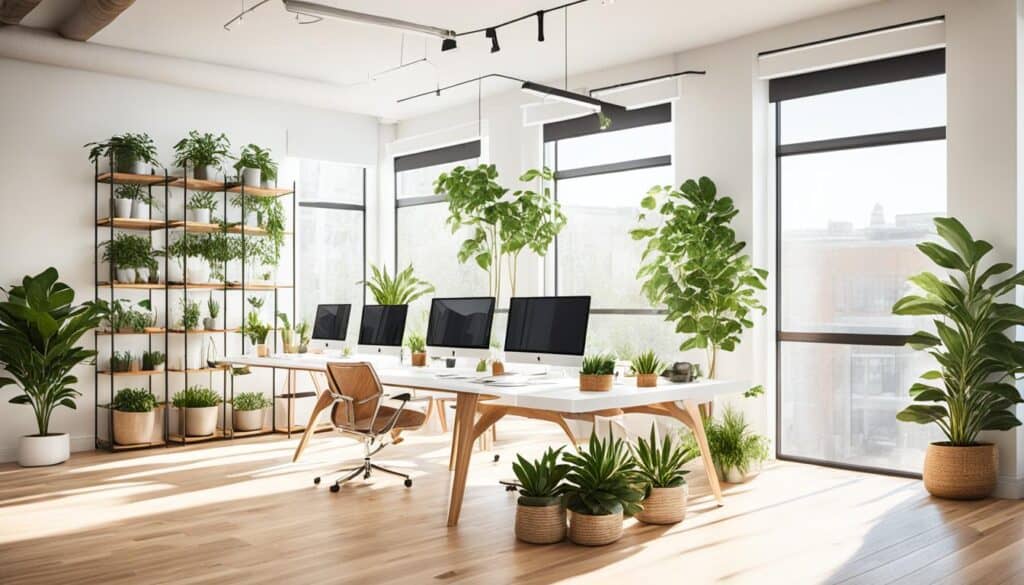
The post-pandemic workspace places a significant emphasis on employee wellness and prioritizes the integration of wellness features into the office environment. It is now widely recognized that a healthy and comfortable workplace directly contributes to employee well-being and productivity.
Natural Light
One essential wellness feature in the post-pandemic workspace is the incorporation of natural light. Exposure to natural light has numerous benefits, including improved mood, enhanced focus, and increased vitamin D levels. It is recommended to position workstations near windows to maximize natural light intake and to create a more vibrant and inviting workspace.
Indoor Plants
Indoor plants have become increasingly popular in office spaces due to their positive impact on employee wellness. They not only add a touch of natural beauty but also contribute to improved air quality by filtering out toxins and increasing oxygen levels. Moreover, indoor plants create a calming and stress-relieving environment that enhances employee well-being and productivity. Consider incorporating a variety of plants throughout the workspace to create a green and lively atmosphere.
Ergonomic Furniture
Ergonomic furniture plays a crucial role in supporting employee health and well-being. Providing adjustable chairs, standing desks, and ergonomic accessories such as monitor arms helps employees maintain proper posture and reduce the risk of musculoskeletal disorders. Creating a workspace that prioritizes employee comfort and ergonomics can significantly enhance productivity and reduce fatigue.
Air Quality
Improving air quality is another important consideration in the post-pandemic workspace. Good air quality contributes to a healthier work environment by reducing the spread of airborne viruses, preventing allergies, and improving cognitive function. Implementing proper ventilation systems, air purifiers, and using low-VOC (volatile organic compounds) materials can greatly enhance the air quality within the workspace and promote employee wellness.
Incorporating these wellness features in the post-pandemic workspace creates a healthier and more comfortable environment for employees. By ensuring ample natural light, introducing indoor plants, providing ergonomic furniture, and improving air quality, employers can support employee well-being, enhance productivity, and foster a positive working atmosphere.
Enhanced Connectivity in Future Workspaces
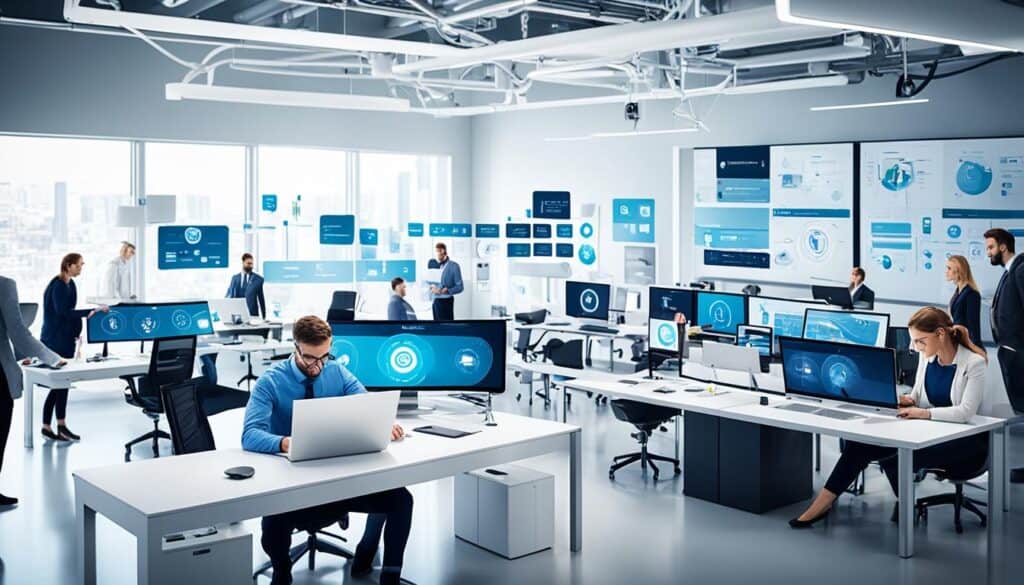
As technology continues to advance, the connectivity in future workspaces becomes increasingly paramount. These workspaces are designed to leverage high-speed Wi-Fi and 5G networks, enabling seamless communication and collaboration among employees.
One key aspect of enhanced connectivity is the Internet of Things (IoT). With IoT, devices and objects within the workspace are connected and can communicate with each other. This connectivity allows for improved automation and efficiency, as well as real-time data collection and analysis.
Data analytics and artificial intelligence (AI) play a crucial role in optimizing workspace operations. By leveraging data analytics, companies can gain insights into employee behavior, space utilization, and resource allocation, leading to more informed decision-making.
AI-powered technologies further enhance connectivity in future workspaces. From virtual assistants that can schedule meetings to smart sensors that adapt workplace conditions based on employee preferences, AI transforms the workplace into a dynamic and responsive environment.
With enhanced connectivity, future workspaces empower employees to collaborate effectively, access information seamlessly, and leverage technology for increased productivity. The possibilities are endless, and the future of work is only getting smarter.
The Role of Lighting and Circadian Design
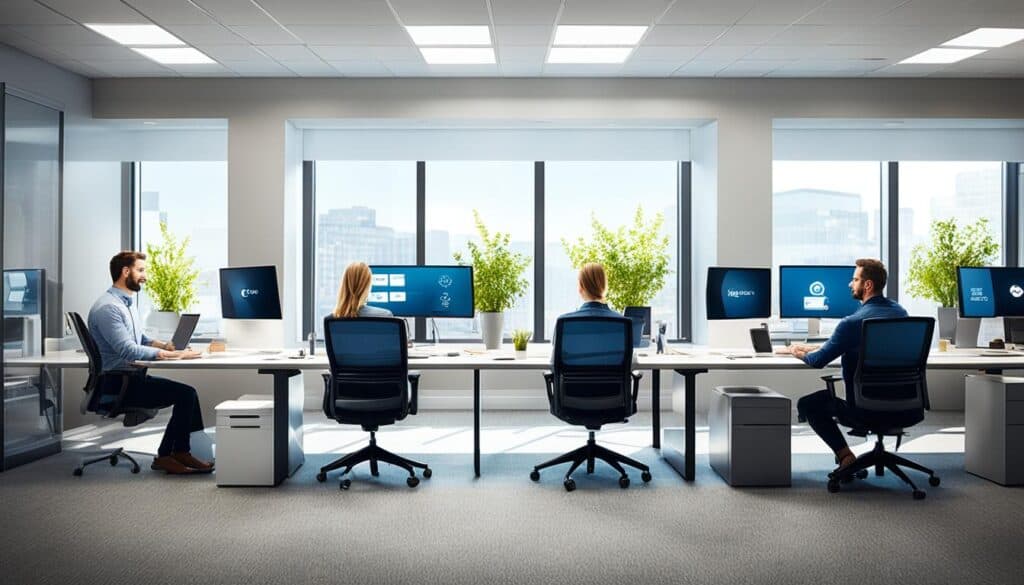
Proper lighting is an essential element of workspace design that significantly impacts employee well-being and productivity. Both natural light and artificial light play a crucial role in creating an environment conducive to work. Circadian design, in particular, focuses on aligning lighting with the body’s natural sleep-wake cycle, known as the circadian rhythm.
Natural light, also known as daylight, has been proven to have numerous benefits on employee health and performance. Exposure to natural light helps regulate the circadian rhythm, enhances mood and mental well-being, boosts vitamin D levels, and improves overall sleep quality.
Circadian lighting systems mimic the natural progression of light throughout the day, adjusting the color temperature and intensity of artificial light to align with the body’s natural rhythms. This promotes alertness and productivity during the day and facilitates relaxation and better sleep quality at night.
Integrating circadian design principles into workspace lighting can have significant benefits for employees, particularly those who work long hours or in environments with limited access to natural light. By supporting the body’s natural circadian rhythm, circadian lighting enhances sleep quality, reduces fatigue, and improves overall well-being, leading to increased productivity and job satisfaction.
Creating Workspaces for Well-being and Productivity
When it comes to designing workspaces that foster well-being and enhance productivity, there are several key factors to consider. One of the most important aspects is lighting. Adequate lighting, both natural and artificial, plays a significant role in creating a comfortable and energizing environment. It helps to minimize eye strain, boosts mood, and improves focus. Employers should strive to incorporate ample lighting options, including adjustable task lights and access to natural light sources.
Ergonomics is another essential element in workspace design. Providing employees with ergonomic furniture, such as adjustable chairs and standing desks, promotes proper posture and reduces the risk of musculoskeletal disorders. Creating a comfortable and supportive workspace allows employees to work efficiently and reduces the likelihood of chronic pain or discomfort.
The choice of color scheme in the workspace can also affect employee well-being and productivity. Calming colors like blues and greens can help create a sense of tranquility and reduce stress levels. Vibrant colors, on the other hand, can stimulate creativity and energy. Striking the right balance and incorporating visually appealing colors can have a positive impact on employee mood and motivation.
In addition, minimizing distractions in the workspace is crucial for maintaining focus and productivity. Employers should consider implementing sound-absorbing materials, acoustic panels, and even noise-canceling headphones to mitigate noise pollution. Distraction-free zones can be created to provide employees with a quiet space for deep work or concentration. Encouraging breaks throughout the workday allows employees to recharge and rejuvenate, leading to increased productivity and overall well-being.
To further enhance the well-being of employees, biophilia should be integrated into the workspace design. Incorporating elements of nature, such as indoor plants and views of green spaces, can have a calming effect and promote a connection with the natural environment. Research shows that biophilic design improves cognitive function, creativity, and overall well-being.
In summary, designing workspaces that prioritize employee well-being and productivity involves thoughtful consideration of various factors. Adequate lighting, ergonomic furniture, a well-chosen color scheme, minimizing distractions, incorporating biophilia, and providing spaces for breaks and relaxation are all essential aspects to consider. By investing in a workspace that supports well-being, employers can create an environment that fosters productivity and supports the physical and mental health of their employees.
 Fullersears
Fullersears
